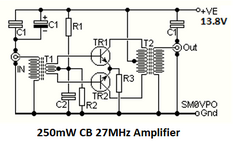anne ranch
Newbie
I understand that only one transistor conduct at a time .
The collectors are connected to start and end of the primary winding of the load.
The center tap is connected to power supply.
What is the direction of EACH part of the load coil ?
Usual "DOT" indicating start is missing from schematic .
Should "dot" be at the collectors ends - hence winding in OPPOSITE direction ?
Or should only ONE collector end have "dot" and the other "dot " being at center tap - hence both winding in SAME direction ?
Or does it matter ?
In theory only part of the wave is active and passed to secondary winding of the impedance transformer.
The collectors are connected to start and end of the primary winding of the load.
The center tap is connected to power supply.
What is the direction of EACH part of the load coil ?
Usual "DOT" indicating start is missing from schematic .
Should "dot" be at the collectors ends - hence winding in OPPOSITE direction ?
Or should only ONE collector end have "dot" and the other "dot " being at center tap - hence both winding in SAME direction ?
Or does it matter ?
In theory only part of the wave is active and passed to secondary winding of the impedance transformer.
